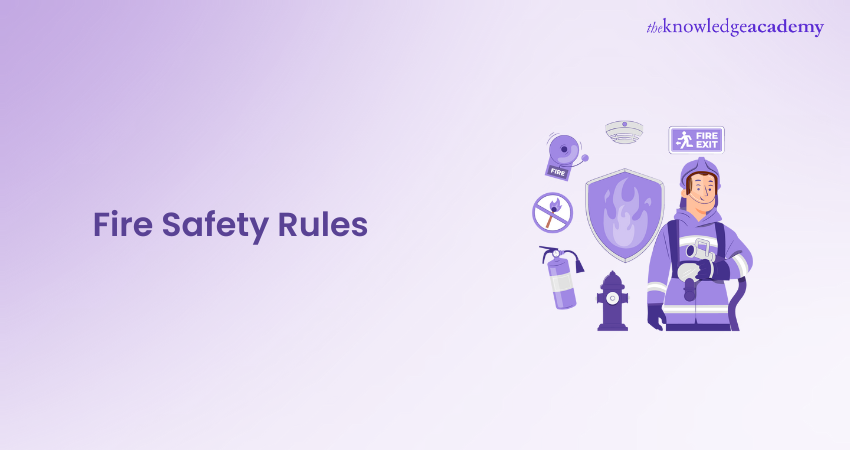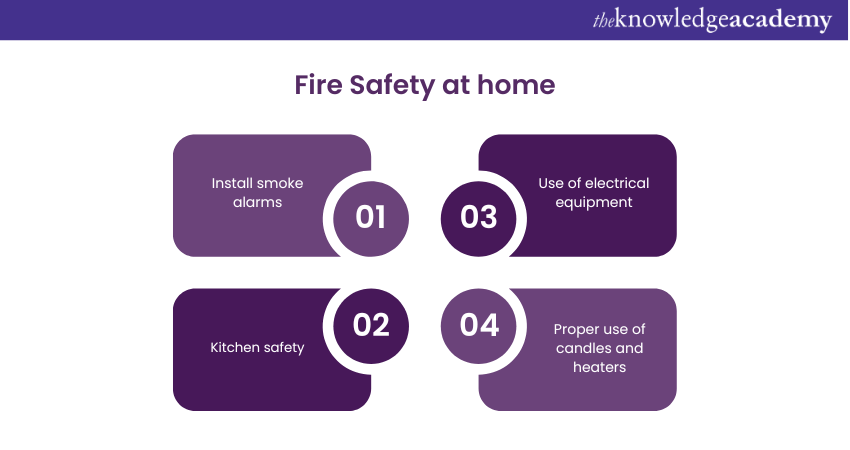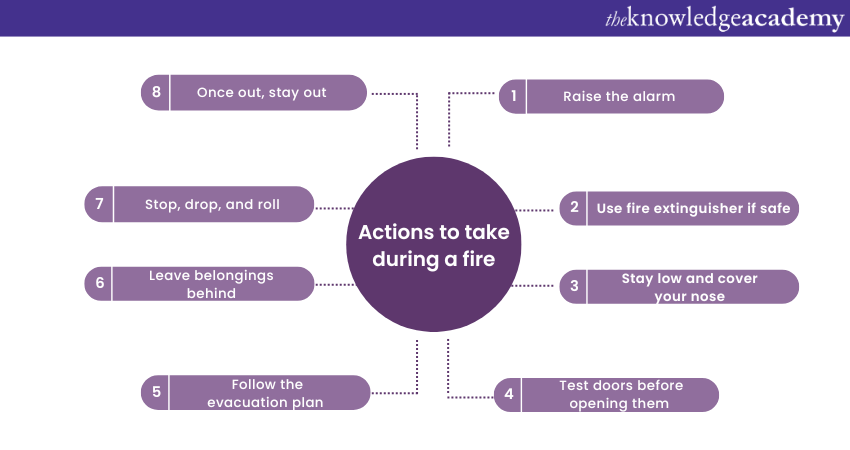We may not have the course you’re looking for. If you enquire or give us a call on +800 312616 and speak to our training experts, we may still be able to help with your training requirements.
Training Outcomes Within Your Budget!
We ensure quality, budget-alignment, and timely delivery by our expert instructors.

Learning basic Fire Safety is a topic of immense importance that often goes overlooked until disaster strikes. The destructive power of a fire is formidable, yet many fires can be avoided by adhering to some simple Fire Safety Rules and procedures.
With millions of people in the world dying due to fire-related accidents, the significance of knowing Fire Safety Rules is more important now than it has ever been. So, wait no more to promote safety. Read this blog to learn Fire Safety Rules, prevent your surrounding from all kinds of fire hazards and promote Fire Safety. Delve in to learn more!
Tables of Contents
1) Introduction to fire safety
2) General fire hazards
3) What's covered by fire safety law
4) Fire Safety at home
5) Fire Safety at work
6) Actions to take during a fire
7) Conclusion
Introduction to fire safety
Fire Safety Rules and Regulations are meant to be preventive, investigative, and responsive in order to protect people and assets from hazards such as fire. This includes replacing smoke alarms on a regular basis, installing fire extinguishers, practising emergency procedures frequently and maintaining fire detection equipment.
The goal of fire safety measures is to reduce the chance of fires and the possible effects they could have on people and their surroundings by increasing awareness, educating the public, and following to Fire Safety Rules.

General fire hazards
Fire needs three things to start:
a) A source of ignition (heat): Depending on how the ignition happens, the most likely sources will vary among the numerous others. Electrical sparks, static electricity, hot surfaces, friction, collision, and so forth are sources of igniting. Any substance that may ignite and release energy as heat is a fuel source.
b) A source of fuel: A fuel source is any substance that has the ability to ignite and produce energy as heat. Examples of fuel source are wood, oil, coal, natural gas and rubber or foam.
c) Oxygen: Oxygen plays a crucial role in the combustion process and acts as a necessary component in maintaining and expanding fires.
What's covered by fire safety law
The fire safety order covers practically every place that people visit, stay, or work. Common areas of multi-occupancy homes, for instance, are included, such as offices, factories, schools, restaurants, houses of worship, libraries, and museums.
The law
The Regulatory Reform Order 2005 is the primary piece of law governing fire safety in buildings in England and Wales.
The FSO extends to all workplaces and the common areas of buildings which contain two or more living premises. It imposes legal obligations on everyone in control of these buildings to conduct and document a fire risk assessment, as well as carry out and uphold general fire measures.
The Fire Safety Order was strengthened in 2022 and came into force on 23 January 2023. The changes are as follows:
a) The law requires people in flats to share building details with fire services and put up signs.
b) Lifts and firefighting gear in all flats must be checked regularly.
c) Buildings with many flats over 11 meters tall must be checked with fire doors every three months and flat doors every year.
d) The law includes Fire Safety Rules covering outside walls, cladding and flat doors.
Penalties
According to the 2023 law, penalties for fire safety breaches include:
a) In serious cases of negligence to comply with Fire Safety Rules, you could face fines or imprisonment.
b) Authorities have the power to issue disciplinary notices, requiring you to take immediate action to rectify fire safety deficiencies.
c) Legal proceedings may be initiated against you as a responsible person or property owner for failing to meet your fire safety obligations.
Fire Safety at home
The following are some Fire Safety Rules that you must adhere to in order to ensure Fire Safety at home:

Install smoke alarms
The first barrier against fire threats is a smoke alarm. Smoke alarms should be installed in each room and on every floor of your residence. It's ensured they stay functional with routine testing and battery replacements.
Kitchen safety
Usually, home fires begin in the kitchen. As such, always cook carefully and never leave your kitchen unattended when the oven or stove is on. Hold flammable items like oven mitts and tea towels away from the heat source.
Use of electrical equipment
Whenever utilising power outlets, remember not to overload them and check for broken wires often. Ensure that, while not in use, all electronic devices are unplugged or turned off.
Proper use of candles and heaters
Never turn on candles or heaters when not around. Make sure heaters are set well away from combustible objects, candles are held in secure holders.
Fire Safety at work
You should adhere to the following Fire Safety Rules to guarantee Fire Safety at work:
Maintain clear exit routes
In case of an emergency, swift evacuation is essential. Exit routes and fire doors should be free from obstructions at all times.
Regular fire drills
Fire drills help prepare employees for emergencies. Regular drills familiarise everyone with evacuation procedures, reducing panic during real incidents.
Safe storage of flammable materials
Workplaces often have a variety of flammable materials. These should be stored safely, away from ignition sources.
Actions to take during a fire
Knowing what has to be done in the sad case of a fire can make a big difference in the result. Keeping composed, making sure oneself safe, sounding an alert, and employing the available fire safety equipment appropriately are all part of these steps.

1) Raise the alarm
When a fire is found, sound the alarm first. Shouting to warn people around or setting off the closest fire alarm will do the job. Give the fire brigade exact information about the location and type of the fire right away when it becomes safe to do so.
2) Use a fire extinguisher if safe
If the fire is controllable and you have the skills to handle, you may be able to extinguish it with a fire extinguisher. But it's important to avoid putting yourself in risk. You should leave immediately if you are unsure about your ability to put out the fire.
3) Stay low and cover your nose
Recall that smoke rises to the ceiling, so there is less smoke at floor level if you find yourself in a position where the room is full of it. Once on your hands and knees, crawl, if you can, to the closest exit. Reduced smoke inhalation can also result from covering your nose and mouth with a moist towel.
4) Test doors before opening them
Before opening any door during a fire, test it with the back of your hand. If it's warm to the touch, there could be a fire on the other side. In that case, look for another exit. If the door isn't warm, gradually open it and be ready to close it immediately if smoke or fire is present.
5) Follow the evacuation plan
Every building should have an evacuation plan, usually involving designated escape routes and assembly points. Follow these plans swiftly but calmly. Do not use elevators during a fire; always use the stairs.
6) Leave belongings behind
Your safety is paramount; your belongings can be replaced. Do not waste precious time collecting items.
7) Stop, drop, and roll
In case your clothing catches fire, keep in mind to "Stop, Drop, and Roll". Avoid running since that could make the fire spread. To put out the flames, take to the ground, cover your face, and move side to side.
8) Once out, stay out
Once you've safely evacuated, do not re-enter the building under any circumstances until the fire brigade has given the all-clear.
Conclusion
Fire Safety Rules are simple yet crucial. Implementing these Rules can ensure that you are prepared to face a fire incident and minimise its devastating effects. Understanding, observing, and promoting the Rules of Fire Safety should be a common responsibility shared by all. You must keep in mind that Fire Safety is not just a rulebook, but a way of life that guarantees our safety and well-being.
Empower yourself with vital skills to protect your life and property by signing up for our Fire Risk Assessment Training today!
Frequently Asked Questions

Legal requirements for fire safety include implementing measures to prevent fires, conducting regular risk assessments, providing adequate fire detection and warning systems and ensuring safe evacuation procedures.

The four elements of fire prevention are identifying fire hazards, reducing ignition sources, implementing controls to contain or suppress fires, and educating individuals on fire safety practices.

The Knowledge Academy takes global learning to new heights, offering over 30,000 online courses across 490+ locations in 220 countries. This expansive reach ensures accessibility and convenience for learners worldwide.
Alongside our diverse Online Course Catalogue, encompassing 17 major categories, we go the extra mile by providing a plethora of free educational Online Resources like News updates, Blogs, videos, webinars, and interview questions. Tailoring learning experiences further, professionals can maximise value with customisable Course Bundles of TKA.

The Knowledge Academy's Knowledge Pass, a flexible prepaid voucher system, offers the freedom to enrol in courses over a 12-month period. Start your limitless learning adventure with us and embrace education that knows no bounds.

The Knowledge Academy offers various Fire Safety Training, including Fire Safety Training, Fire Warden Training, Fire Extinguisher Training and Fire Risk Assessment Training. These courses cater to different skill levels, providing comprehensive insights into Fire Safety System.
Our Health & Safety Blogs cover a range of topics related to Fire Safety Rules, offering valuable resources, best practices, and industry insights. Whether you are a beginner or looking to advance your Health and Safety skills, The Knowledge Academy's diverse courses and informative blogs have you covered.
Upcoming Health & Safety Resources Batches & Dates
Date
 Fire Safety Training
Fire Safety Training
Fri 21st Feb 2025
Fri 27th Jun 2025
Fri 26th Sep 2025
Fri 21st Nov 2025







 Top Rated Course
Top Rated Course


 If you wish to make any changes to your course, please
If you wish to make any changes to your course, please


